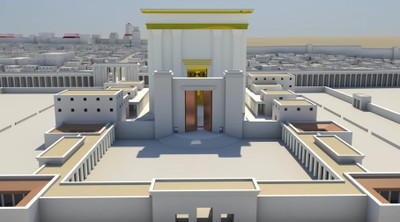In Mark 13:1, Jesus is leaving the Jerusalem Temple complex where he has been teaching, and one of his disciples says to him, “Teacher, look! What massive stones! What impressive buildings!” Jesus then makes the shocking declaration, “Do you see these great buildings? Not one stone will be left here on another that will not be thrown down!”
When I read this passage, I can immediately relate to that disciple, because I have personally marveled at some of the man-made wonders I have been able to see in person. When those “impressive buildings” also happen to be symbolic of my nation, feelings of national pride get mingled with my amazement at the architecture. When those “impressive buildings” have a religious significance, I may be moved to devotional reflection. Since the Temple in Jerusalem was an architectural wonder, a source of national pride, and the center of Jewish worship, I imagine that disciple experiencing all of these emotions at once. How bewildered must he then have been at Jesus’ prophecy of the Temple’s destruction?
While I can relate to this passage on the basis of my own similar experiences, I have often wished that I could really know what that disciple was seeing. In fact, a large portion of each of the four gospels is devoted to the final week Jesus and his disciples spent in Jerusalem, so knowing what ancient Jerusalem looked like would contribute to our understanding of a host of other passages as well.
 That is why I’m very excited to announce the release of The Virtual Bible, a new visual resource which offers three-dimensional reconstructions of the land of Israel, first-century Jerusalem, the Herodian Temple, and more. The visuals, which include still images and video fly-throughs, were developed by Dr. Daniel Warner of New Orleans Baptist Theological Seminary and Dr. James Strange of the University of South Florida, in consultation with Leen Ritmeyer, an archaeological architect who is an expert on the Jerusalem Temple.
That is why I’m very excited to announce the release of The Virtual Bible, a new visual resource which offers three-dimensional reconstructions of the land of Israel, first-century Jerusalem, the Herodian Temple, and more. The visuals, which include still images and video fly-throughs, were developed by Dr. Daniel Warner of New Orleans Baptist Theological Seminary and Dr. James Strange of the University of South Florida, in consultation with Leen Ritmeyer, an archaeological architect who is an expert on the Jerusalem Temple.
One of the videos we received is narrated by Dr. Strange and takes you on a virtual tour through the places Jesus visited during his last week in Jerusalem. The other videos were more of a blank slate. They flew through important features of first-century Jerusalem, but there was no accompanying narration to explain what you were looking at. We therefore added narration and music to these videos to improve their teaching value for those of us who might need a tour guide. We also added detailed text descriptions for each still image and video. Finally, we included links to The Bible Lands PhotoGuide to give you more information about sites in Israel, as well as links to Leen Ritmeyer’s The Quest to give you more information about the Herodian Temple. The result is a tool which I think you’ll find incredibly informative.
I actually tested some of the Virtual Bible videos on my Sunday School class yesterday. First, I showed them the Passion Week video narrated by Dr. Strange. Here’s a sample:
I let the video run, then asked if anyone had any questions or comments about what they had seen. When that first wave of discussion died down, I started asking probing questions to get them to consider other aspects of what they had seen. For example, I asked if anything struck them as odd about the reconstruction of the sites of Jesus’ crucifixion and his tomb. One person expressed surprise at how close they were to each other. I then rewound the video to a point that showed the hill of Calvary and asked, “Does this look like a natural hill to you?” Someone then observed that the hill looked like it had been cut. I explained that this was exactly right, since the crucifixion and burial sites are believed to have been located around an abandoned quarry outside the city walls. Someone later asked me where the Western Wall is located, so I showed a different movie which flies right along what is today known as the Western or Wailing Wall.
If you’re interested in learning more about ancient Israel and being able to explain events like those in the gospels and the opening chapters of Acts, you owe it to yourself to get The Virtual Bible. Not only are the images and videos really cool, but like all our visual resources, we’ve designed it to be a highly effective teaching tool.


